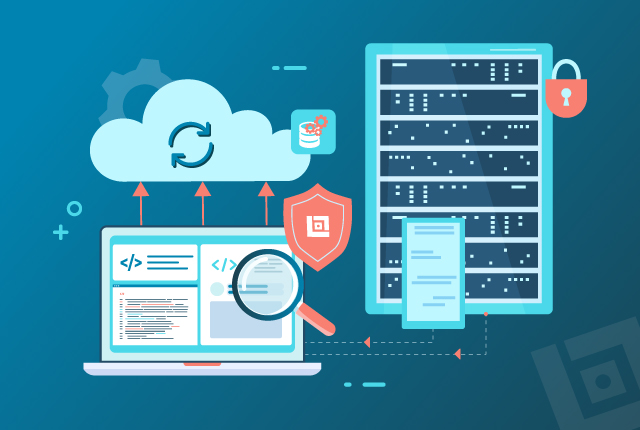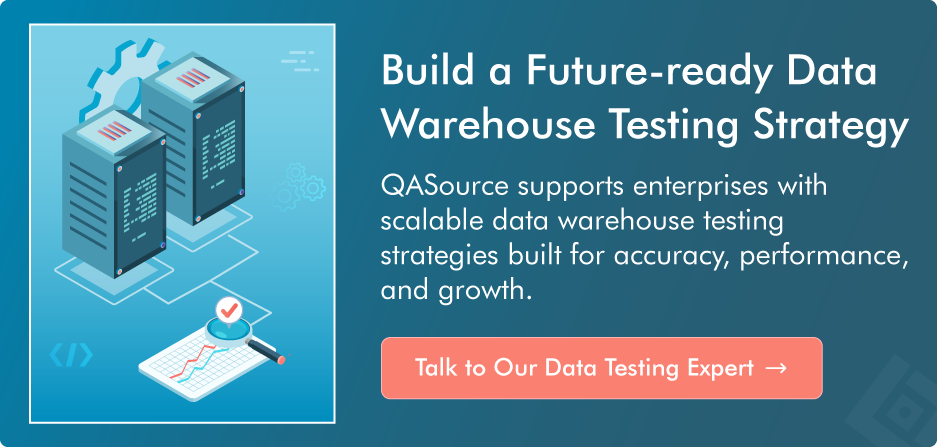
Table of Contents
- What is data warehouse testing in quality assurance?
- Key components of a data warehouse testing strategy
- What is the importance of data warehouse testing?
- How to build a data warehouse testing strategy?
- Best practices for data warehouse testing
- What are the commonly used data warehouse automation testing tools?
- Latest AI trends in 2026 for Data Warehouse Testing
- Conclusion
Businesses need accurate data to make strategic decisions, analyze data, and predict success. Companies lose millions of dollars annually because of bad data quality, making people lose trust in business intelligence. In fact, bad data quality can cost businesses up to 25% of their total revenue.
Data warehouses are the main storage area for business data. They bring together data from many different systems into one place. Testing these repositories makes sure that the data stays consistent, correct, and ready for important analysis. This blog talks about the most effective ways to test and plan a data warehouse in 2026.
You will learn about the basic ideas behind testing, the most important data warehouse automation testing tools, and its various benefits.
What is Data Warehouse Testing in Quality Assurance?
A data warehouse is a single place where structured data from many sources is kept for analysis.
By putting historical data into a standard format, it becomes easier to report, analyze, and make decisions.
Data warehouse testing checks that data is correct, complete, and consistent across the source, staging, and target layers. Before analytics teams trust reports, it ensures that business rules, transformations, and aggregations all work as they should.
Using reliable data warehouse testing tools, testers stop errors from happening later and help people trust insights. The following are its key objectives:
- ETL Testing: Checking that data is correctly extracted from source systems and loaded into the data warehouse.
- Data Quality Testing: Profiling and cleaning up data to make sure there are no duplicates, nulls, or inconsistencies.
- Regression Testing: Making sure that changes to ETL processes don't break things that already work.
- Performance Testing: Making sure that queries and data loads run within acceptable limits.
- Security Testing: Ensuring that role-based access and data masking work properly, especially to follow HIPAA and GDPR guidelines.
Key Components of a Data Warehouse Testing Strategy
A good data warehouse testing strategy needs to do more than just basic validation. It should cover the entire data lifecycle, from ingestion to final reporting. This ensures that every movement, transformation, and data output is correct and consistent with business goals. Let’s check out the key components of an effective strategy:
- Data Completeness: Ensure that all the data is in the warehouse and none of it is missing. This includes counting records, checking for NULL values, and making sure that the source and target systems align.
- Data Accuracy: Check that the values in the warehouse match those in source systems to make sure they are correct. To find format mismatches, wrong mappings, or rounding problems, compare each field to the others.
- Transformation Logic Validation: Verify that testers apply business rules and data transformations correctly. Make sure that calculations, aggregations, lookups, and derived fields are correct according to the requirements.
- Data Model Conformity: Makes sure that the data's structure and relationships are correct and usable. This means checking names, relationships, and table formats to make sure they are all the same.
- Metadata and Schema Validation: Ensure that the database objects (like tables, columns, etc.) are correct and match specifications. This is very important when you update or move data.
- Data Integrity Testing: Check the primary keys, foreign keys, and uniqueness rules to make sure the data is correct. Make sure there are no records that are missing or that are the same.
- Testing Dimensions and Hierarchies: Check Slowly Changing Dimensions (SCDs), hierarchies (like time or location), and drill-down structures. This makes sure that reports can accurately show data.
- Access Control and Security Validation: Make sure that private information is safe. Check that access controls, data masking, and logging systems are up to compliance standards like HIPAA or GDPR.
- Integration Testing: Make sure that data moves correctly between systems, such as source, staging, warehouse, and BI tools. This ensures that data moves smoothly and consistently from start to finish.
- Regression Testing: After making changes to the ETL logic, schema, or configuration, run the test cases again. It ensures that the existing functionality is still working without any adverse effects.
- Scalability and Performance Testing: Check how well the system works when it's busy and when it's not. Check how long it takes to respond to queries, load data, and make the system bigger.
- Reporting and BI Validation: Check that reports and dashboards show the right metrics and use filters correctly. Follow the expected business logic across tools like Power BI, Tableau, or Looker.
- User Acceptance Testing (UAT): Help business users make sure that final data outputs are what they should be. This includes testing sample reports, real-life situations, and common questions.
- Monitoring and Alert Readiness: Verify if proactive monitoring systems, like data freshness alerts or quality thresholds, are working. It helps testers find out pipeline problems early.
- Post-deployment Validation: After the system goes live, QA checks that data is still flowing correctly in production. It checks that dashboards, reports, and integrations are stable and up-to-date.
What is the Importance of Data Warehouse Testing?
Data warehouse testing verifies that the data is correct, reliable, fast, and safe. By checking the integrity, consistency, and transformation logic of data, businesses make fact-based decisions. Let’s read about the importance and benefits of data warehouse testing.
- Better Decision-making Accuracy: Testing a data warehouse makes sure that reports and dashboards use accurate and validated data. It makes business analysis more reliable and effective. The level of accuracy helps leaders make data-based decisions that will have a measurable effect on the business.
- Lowers Costs and Operational Waste: Early data warehouse testing finds problems with data quality and performance before they turn into expensive production failures. The approach cuts down on rework, infrastructure waste, and downtime, all of which hurt budgets and operational efficiency.
- Faster Time to Insights: Testing a stable data warehouse makes the pipeline more reliable, cutting down data errors and broken transformation delays. Teams get trustworthy insights faster, helping with analytics, reports, and intelligent business decisions.
- Improved Data Trust and Governance: Data warehouse testing ensures that data is complete and comes from the right sources, transformations, and analytical layers. The validation helps the organization build trust and supports governance standards, audits, and efforts to stay compliant in the long term.
- Competitive Advantage: Regular testing makes it easier to spot trends and make accurate predictions using reliable, high-quality analytical data. Companies can quickly adapt to changes in the market, beat their competitors, and take advantage of opportunities with confidence.
- Better Productivity and User Experience: Well-tested data warehouses give analytics and business users reports that load quickly and are accurate. Better reliability means higher productivity because teams can focus on insights instead of problems with data validation.
- Risk and Compliance Mitigation: Testing keeps sensitive and regulated information safe, hidden, and only accessible to the right people. It lowers the risk of not following the rules and helps meet rules like GDPR, HIPAA, SOX, and others.
How to Build a Data Warehouse Testing Strategy?
Data quality goals are in line with business needs and analytics goals when a robust data warehouse testing strategy is implemented. The following steps help create a successful data warehouse testing strategy for businesses:
- Define Requirements and Business Objectives: Work with stakeholders to ensure everyone knows what the data warehouse is for and what results you need. Write down the business rules, reporting needs, data sources, and legal requirements (like GDPR and HIPAA).
- Create a Detailed Test Plan: Make a full document that lists the testing's goals, tools, people, environments, and timeframes. You must know the ways to manage risks and the roles and responsibilities of each person.
- Prepare the Data and Test Environment: Set up a separate test environment that looks like the production architecture. Use controlled, production-sized, and anonymized test data sets. It ensures that test runs are realistic and testers can repeat them without putting sensitive information at risk.
- Implement ETL Testing at Every Stage: Check the data at every step of the data pipeline. Make sure to correctly pull the necessary data from the source systems. Correctly execute business rules, calculations, aggregations, and data cleaning. Verify that you correctly load data into the warehouse without any loss, duplication, or truncation.
- Execute Different Types of Testing: Conduct a variety of tests on the data warehouse, including security, performance, accuracy, completeness, and regression testing. The approach ensures proper examination of all reports, data pipelines, transformations, and business-critical analytical use cases.
- Leverage Automation and Monitoring: To minimize manual labor and identify problems prior to production deployments, incorporate data warehouse testing into CI/CD pipelines. Keep an eye on production data quality and performance at all times, and set up alerts to let teams know when unforeseen anomalies occur.
- Document and Report: Maintain comprehensive records of test cases, execution logs, errors, and final test results for compliance and auditing purposes. The method allows for continuous improvement across data warehouse testing projects, improves traceability, and facilitates stakeholder communication.
Best Practices for Data Warehouse Testing
Teams preserve data accuracy, performance, and long-term dependability using data warehouse testing best practices. These procedures guarantee that analytics teams can rely on enterprise data results with confidence.
- Automate Repetitive Testing Tasks: To increase productivity, automate repetitive data warehouse testing checks like record counts, transformations, and validations. Using data warehouse automation testing tools decreases human error, speeds up execution cycles, and expands testing coverage.
- Early Involvement of Business Users: Involving business users in data warehouse testing guarantees that metrics and reports match actual business requirements. Their involvement in user acceptance testing verifies the accuracy, usability, and relevance of the data for decision-making scenarios.
- Use Iterative Testing Techniques: Iterative data warehouse testing helps find problems early by checking data at different points in the agile development process. Early and frequent testing stops defects from building up, which leads to faster and more reliable data pipeline releases.
- Emphasis on Business Impact: Sort data warehouse testing flaws according to how they affect analytics, reporting precision, and business choices. This method makes sure that important data problems that affect insights are dealt with before low-risk technical problems.
- Conduct End-to-End Data Validation: End-to-end data warehouse testing checks the whole process, from the source systems to the final dashboards. It makes sure that the transformation, aggregation, and presentation layers all work together to give you accurate analytical results.
What are the Commonly Used Data Warehouse Automation Testing Tools?
To work with big datasets, complicated transformations, and data that changes often, you need automation tools. Choosing the right data warehouse automation testing tools makes testing faster, more accurate, and more scalable across all enterprise data pipelines.
- QuerySurge: QuerySurge effectively validates big datasets across intricate ETL pipelines.
- Informatica Data Validation: It accurately compares source and target data following transformations to automate data warehouse testing.
- Talend Data Fabric: It provides integrated data quality, profiling, and automated validation features to support data warehouse testing.
- Apache Airflow: Apache Airflow orchestrates and monitors automated data warehouse testing workflows and dependencies.
- dbt Tests: dbt Tests validate constraints, transformations, and business logic in analytics pipelines.
- Datagaps ETL Validator: It concentrates on automated data warehouse testing for ETL procedures with reporting and reconciliation features.
Latest AI Trends in 2026 for Data Warehouse Testing
Teams are validating large datasets more quickly and accurately thanks to AI-driven testing. In 2026, data warehouse testing strategies in contemporary businesses are evolving with intelligent automation and predictive analytics.
- AI-native Data Observability With Predictive Alerting: AI-native data observability watches out for pipelines that expect failures before dashboards and SLAs do. With the help of identified anomaly patterns, teams move from reactive checks to proactive alerts in data warehouse testing.
- LLM-assisted Test and Rule Generation: LLMs now help teams write test cases and validation SQL directly from functional and data requirements. Domain experts use their business knowledge to review and change these outputs, which makes them more complete without making the documentation too long or heavy.
- Agentic Pipelines for Automated Remediation: Agentic pipelines keep an eye on data workflows all the time and automatically fix problems or inconsistencies when they happen. Routine fixes happen on their own, but complex or risky actions still need to be approved and watched by a person.
- Metadata Intelligence for Faster Root-cause Analysis: Using lineage visibility, metadata intelligence helps teams find the source of data problems by following the data through its sources, transformations, and ownership. Linking the results of data warehouse testing to governance processes speeds up the process of finding the root cause and holding everyone accountable.
- Synthetic Data Generation for Edge-case Simulation: Synthetic data generators make realistic edge cases like drift patterns, null bursts, and strange joins. Teams make data warehouse testing suites stronger overall by safely checking rules before they go into production.
- AI-scale Monitoring for Tool Consolidation: In order to reduce blind spots, licensing costs, and sprawl, organizations now combine quality and observability tools. Cost-aware monitoring makes sure that data warehouse testing is in line with business impact by focusing on high-value datasets and queries.
Conclusion
Data warehouse testing will be very important in 2026 as the amount and complexity of data grow. A clear testing strategy makes sure that modern analytics ecosystems have accurate, high-performing, well-governed, and reliable insights.
By combining automation, AI trends, and best practices, organizations can build reliable, future-ready data platforms. QASource assists businesses through scalable data warehouse testing techniques that produce trustworthy insights and quantifiable business value.



